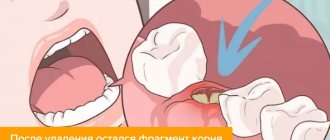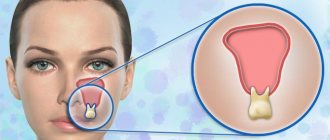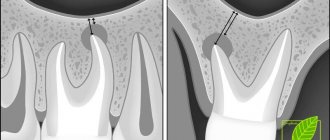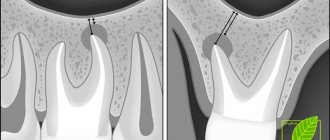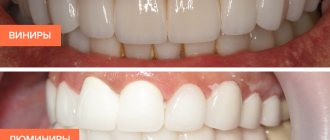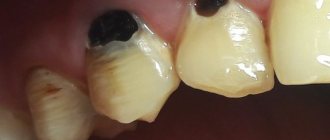Despite the rapid development of methods and technologies in dentistry, complications can arise even during therapeutic treatment. Tooth perforation, or perforation, is a violation of the integrity of the root or crown, as a result of which infection affects healthy tissue. Read about the causes of this problem and how to fix it in the Startsmile reference book.
Why does damage occur?
A patient may experience a perforation for several reasons.
- Mechanical injury. A blow or bruise to a tooth, as well as a medical error during treatment and filling of a canal, installing a crown or fixing an inlay, which indicates low qualifications or insufficient experience of the specialist.
- Anatomical and physiological features of humans. Narrowed or curved roots, incorrect position of canines, incisors and molars, jaw displacement, and bone atrophy can complicate the treatment process and lead to tooth perforation.
- Caries. The disease softens the dental tissue, in place of which a through hole appears from the top of the canal to the bottom of the crown.
Causes
Perforation of a tooth is simply called a hole. This hole is similar to advanced caries, but often forms for completely different reasons. One of them is the careless actions of the dentist.
In addition to improper actions by the dentist, a hole in the tooth can appear as a result of:
- untreated caries;
- mechanical influence from the outside;
- anatomical features of the jaw shape.
Dentist mistakes
How can improper dentist practices cause a crack or hole in the crown and root? This may occur due to the difficulty in treating the internal structures of the tooth. The obstacles are the branches of the root canals, which make it difficult to access the site of infection. A tooth can also become perforated while increasing the space of the canals with a drill or in preparation for installing a pin.
Perforation of a molar during treatment is accompanied by a sudden pain syndrome and the appearance of blood from the site of the lesion.
Mechanical impact from the outside can provoke a strong blow or careless actions of the dentist while cleaning the dental canals. You need to seek dental help from experienced doctors, read reviews about clinics and give preference to treatment with modern equipment.
An inexperienced dentist may apply force during endodontic correction of a tooth, which will inevitably lead to the appearance of a crack or deep hole. Working with low-quality or outdated instruments can lead to their sudden breakage and getting stuck in the dentin tissue. It is not possible to eliminate pathology without a special microscope. As a result, after a few days the patient’s jaw begins to hurt severely and the periodontal tissue becomes inflamed.
In modern dental clinics, doctors wear special magnifying binocular glasses and use microscopes. This reduces the risk of tissue perforation.
Other reasons
Neglect of the oral cavity and untimely treatment of caries always leads to perforation and even loss of a molar. Complications of caries are dangerous both for the tooth and gum tissue, and for the general health of the patient.
The cause of perforation may be:
- malocclusion;
- tooth damage during sleep;
- wedge-shaped defect;
- demineralization of enamel;
- denture not removed during surgical treatment.
How does a perforated molar hole differ from a carious cavity? When perforation occurs, multiple cracks may form on the surface of the crown. With caries, cracks do not form on the enamel.
Anatomical features of the jaw structure (curved root canals) often prevent thorough sanitation of carious cavities and can cause careless actions by the dentist.
Perforation of the tooth root
Most often, perforation of the tooth canal occurs as a result of poor-quality endodontic treatment. It is impossible to visually determine the damage; symptoms of tooth root perforation such as bleeding from the canal cavity and pain when chewing food should alert you. If the hole is not eliminated in time, the inflammatory process will reach the peri-root tissues, which can lead to periodontitis.
The bifurcation area, or where the tooth roots separate, is considered a vulnerable area. This area unites all the dental canals, as well as part of the periodontal tissue, and in the event of perforation of the tooth bifurcation, the infection will destroy several healthy segments at once.
What is perforation and its types
Perforation refers to tooth pathology, which manifests itself as a hole in the dental tissue that flows into the tooth cavity. A phenomenon such as perforation is rare, but the defect is quite serious and requires mandatory treatment. Depending on the location, the following types of perforation are distinguished:
- Bottom of the tooth cavity. This type of perforation is observed when the dental axis is displaced and can develop against the background of abrasion of the tooth surface. More often, the development of such perforation is caused by a strong expansion of the dental cavity, which can form during the treatment process.
- Tooth root. This type of perforation is the most common and requires immediate treatment, as it can cause the development of a destructive process in the periodontium. One of the main factors for perforation is incorrectly positioned or twisted roots. To find out the location of the hole in the canal, an x-ray is performed.
- Walls of the tooth. The formation of perforation in the area of the dental walls is caused by improper manipulations by the dentist. Its manifestation is the result of inaccurate strong impact on the tooth during its treatment. This pathology can be detected immediately, as gum bleeding and pain appear.
Depending on the time of manifestation of perforation, it can be fresh - it appears immediately after formation, and old, when the pathology has no symptoms for a long time, it becomes the cause of infection of dental tissues. If the defect is not corrected in time, the affected segment of the tooth, as well as the tooth as a whole, may be lost.
Treatment of tooth root perforation
There are three methods for eliminating perforation - conservative, conservative-surgical and surgical.
- The defect, which is located close to the crown and is clearly visible on an x-ray, is sealed and filled.
- If there is chronic inflammation in the periodontium, it is necessary to make a small incision in the gum to gain access to the hole, remove the infected tissue and seal the cavity.
- Apical damage is corrected only by resection of the root apex.
Symptoms
When should you contact your dentist about suspected perforation? There are indirect and direct symptoms characteristic of this pathology.
Symptoms:
- periodic bleeding from the gums that goes away on its own;
- inflammation of the gums, redness;
- unevenness on the surface of the crown, which can be determined using a tongue or toothpick;
- reactions to changes in food temperature, sweetness and acidity;
- formation of pus in the periodontium, throbbing pain when touched;
- severe pain during dental procedures.
There are also indirect symptoms that may indicate the presence of pathology:
- increased salivation;
- wounds on the tongue while chewing food or resting at night;
- headaches, general weakness, hyperthermia.
Traditional methods of treatment to eliminate perforation are not used. Without dental care, the hole in the tooth will not heal.
Increased salivation and headaches can also appear with other pathologies, but in combination with gum inflammation they suggest a dental disease.
Perforation of baby teeth
Perforation in children is extremely rare, but treatment is also necessary, since periodontitis can develop in both adults and young patients. If the coronal part is damaged, the unit is sanitized and restored. Absorbable materials are used to close tooth root perforations, since the canals of baby teeth disappear over time, giving way to the buds of permanent teeth.
Perforation of the maxillary sinus
In rare cases, the roots of the teeth of the upper jaw are located close to the maxillary sinus or even located in its cavity, separated only by the thinnest mucous tissue. These anatomical features lead to complications - perforation of the maxillary sinus during tooth extraction. In addition, the damage may be due to the rude actions of the doctor.
Perforation of the maxillary sinus during dental treatment usually occurs during endodontic procedures. The cause of perforation is excessive expansion of the canal or, again, low qualifications of the dentist.
Symptoms of perforation of the maxillary sinus during tooth extraction or canal treatment include nosebleeds, bloody discharge from the socket, nasal congestion, the appearance of nasal sounds and a change in the timbre of the patient’s voice.
Therapeutic treatment of perforation of the maxillary sinus during tooth extraction or root cavity cleaning is possible only if damage is immediately detected and there is no infection in the sinus tissue. The doctor places a tampon soaked in an antiseptic into the hole and secures it with a plastic clip for 5-7 days until the perforation is completely healed. Otherwise, the patient is prescribed an operation to open the sinus and remove non-viable tissue.
How to treat tooth perforation at home?
After dental care in a clinic, the patient continues treatment at home. The specialist prescribes individually selected antibiotics with good permeability into bone tissue. It is also recommended to make oral baths with a chlorhexidine solution to relieve inflammation in the gums when a tooth is perforated.
Self-treatment of damage with folk remedies or medications without a prescription is strictly prohibited. This will only worsen your health condition and lead to the spread of infection.
Prevention
You should follow a proper diet and take good oral care at home.
- Cleansing the oral cavity should be done in the morning and before bed; during the day after eating, it is recommended to rinse your mouth with plain water or dental elixirs.
- Instead of a toothbrush, it is recommended to use an irrigator to cleanse the oral cavity. This is especially true for gum inflammation. The irrigator cleans teeth and interdental spaces using a stream of water under pressure. This is a painless and modern method of oral care. Instead of plain water, you can use herbal solutions.
- The diet must be carefully reviewed. The emphasis is towards reducing sweets, baked goods and solid foods. The menu should include fresh and boiled fruits/vegetables, dietary meats, and herbs.
- Dentists advise quitting smoking and drinking alcohol.
- Stop engaging in traumatic sports (martial arts, extreme sports) to minimize the possibility of jaw injury.
- Do not neglect routine dental examinations, which are recommended every six months.
Otherwise, tooth perforation does not depend on the patient. You need to choose trusted clinics and professional dentists to treat caries and other diseases.
Consequences of tooth perforation
The prognosis depends on the size of the cavity, the timeliness of assistance and the location of the perforation. As a rule, damage to the tooth wall, repaired in a short time, occurs without complications. But perforation between the roots of the teeth leads to disruption of the functioning of the unit, which can no longer be used as a support for prosthetics. There is also a high risk of repeated tissue inflammation. Resection of the tooth root during perforation reduces the life support of the tooth through the canals; most often, after some time, it has to be removed.
The most common cause of tooth perforation is doctor error. Excessive effort during the procedure, selection of inappropriate instruments or inattention can lead to tooth loss. This situation can be avoided by choosing a trusted clinic with highly qualified specialists who will not only prevent negligence, but will also provide prompt assistance in unforeseen situations.
Perforations in the area of the dental crown
It occurs most often, and it can be localized both in the area of the wall of the tooth cavity and in the area of its bottom.
The anatomical features of the structure of the patient’s teeth predispose to this type of complications (deviation from the normal central axis, too thin tooth wall, small thickness of the bottom of baby teeth and errors in therapeutic manipulations (incorrect selection of instruments and speed mode of the bur, re-treatment of the tooth, insufficiently wide opening of the cavity , which impairs the view of the tissue being prepared).
Symptoms of the disease
The clinical picture of any fresh perforation is typical. At the moment of its occurrence, a person experiences severe toothache, and the damaged tooth begins to bleed. If this happens in the dentist's office during treatment, the doctor feels the "failure" of the instrument and can visually see blood coming out of the perforation.
Old perforations that were not detected at the time of occurrence and not treated sometimes do not manifest themselves at all, since they are often accompanied not by an acute, but by a sluggish inflammatory process. The patient may experience periodic aching pain. And only upon examination, the doctor discovers granulation tissue in the area of the external opening, which bleeds when touched.
Typically, such perforations are immediately detected by a doctor and repaired with a filling. Moreover, the prognosis for wall damage is almost always favorable. But the result of treatment depends on the size of the perforation hole. If the size of the defect does not exceed 1-2 mm, then filling it can be quite effective. If the size of the canal and hole is more than 2 mm, then closing the tooth perforation will most likely lead to the pushing out of the active material into the periodontium and its infection with the development of severe forms of destructive periodontitis.
Diagnostics
When a tooth is perforated in the area of the visible part of the crown, diagnosis is not difficult, since the defect is visible even to the naked eye. If there are doubts about the presence of a complication, or it occurred in the area of the bottom of the dental cavity, then it is necessary to take X-ray images with contrast (for example, a pin or file can act as contrast).
Treatment of perforation in the coronal area
Closing a tooth perforation is a therapeutic measure that must be carried out as quickly as possible, since without treatment such a complication will lead not only to tooth loss, but also to the development of serious inflammatory reactions.
It is advisable to carry out all medical manipulations under a special microscope, which improves visibility, allows for better processing of the perforation before closing and monitoring the result. The main requirement for dental materials used to fill perforation holes and canals is high biocompatibility with body tissues and the ability to quickly harden even in high humidity conditions. Previously used GIC (glass ionomer cement) and amalgam did not have a sufficient degree of adhesiveness and biological compatibility with dental tissues.
In modern dentistry, tooth perforations are increasingly closed with imported material - MTA cement (mineral trioxide aggregate), which quickly hardens in a humid environment and does not cause rejection reactions.
